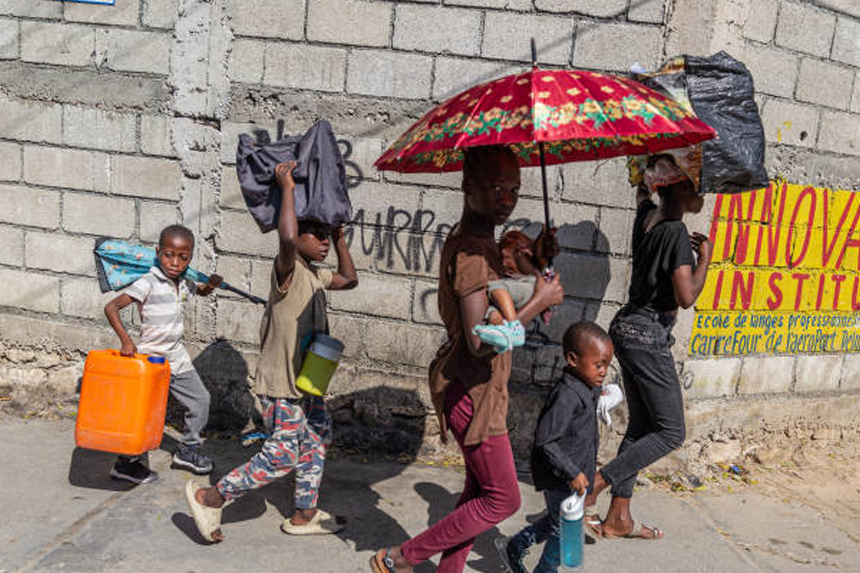A two-year-old child called Shaina sleeps linked to an intravenous drip in one of Haiti’s few surviving functional hospitals. Watching nervously, her mother, Venda, hopes the treatment will help her child’s extreme malnutrition be lessened. She is praying. Shaina’s tale is not unusual; among 760,000 children living in Haiti, she is among those threatened with starvation.
“I want my child to get the correct treatment. Desperate to protect her kid from the effects of hunger, Venda cries tearfully, “I don’t want to lose her.”
What Has caused Haiti's declining state?
Already beset with poverty and unrest, Haiti has been thrown more into trouble following the murder of President Jovenel Moïse in 2021 and uncontrolled gang violence. With the gangs in charge of 85% of Port-au-Prince, the people suffer continual anxiety and suffering.
One feels the consequences of this aggression even inside the hospital walls. The director of the pediatric ward tells how cops ran across gang members inside the ER yesterday, causing mayhem among the already fearful patients.
How are Haitians handling the victims of violence?
Gang-fighting victims abound in the hospital’s hallways. One of the numerous young men in their twenties dealing with gunshot wounds is Pierre. “I stumbled into the crossfire of a gang fight on my way home from work. One bullet passed my collarbone,” he says.
Pierre muses over the underlying reasons for the bloodshed. “They wouldn’t get involved in the gangs if the government were more stable and had set in place better youth programs,” he says. “The young men that join these groups have no other options.”
Might the United Nations offer Haiti a glimmer of hope?
The UN Security Council approved the founding of the Multinational Security Support Mission (MSS) in October 2023 in response to the mounting bloodshed. Funded mainly by the United States, the mission was to restore law and order in Haiti. Arriving in June, the Kenyan-led army found the situation still appalling, with vastly outnumbered officials.
Police from Kenya on patrol in Port-au-Prince come upon the whole force of the violence. Driven across once-bustling neighbourhoods now reduced to barren landscapes are armoured personnel carriers (APC). Homes and businesses are left behind, and the streets are covered in burned-out cars and trash left over from gang-created barriers.
Gunfire bursts as the convoy negotiates the debris. The Kenyan officials had to return fire when bullets struck the armour of the APC. The convoy continues after almost an hour of fierce communication, but the sights of bloodshed still linger. Burned and disfigured, a human body rests in the middle of the street—a sobering reminder of the savagery that rules.
What challenges does the Kenyan Mission in Haiti face?
The Kenyan officials are resolved despite the dangers and tiredness. “We have grown used to seeing this violence on Port-au-Prince’s streets,” one officer says. Still, we are here to bring about order and peace.
Initially 400 strong, the Kenyan troops were promised more help, but delays have left them outnumbered. Although the force was intended to grow to 2,500, just 1,000 more cops will show up by year’s end. Notwithstanding the difficulties, Commander Godfrey Otunge still finds hope. “The population is asking that we be present in various spheres. They wish for us to help to calm the city.”
Why Are Certain Port-au-Prince Areas Under Gang Rule?
Wharf Jérémie is one of Port-au-Prince’s most hazardous neighbourhoods; gangs have seized control with extreme violence. Over a single weekend in December, one gang claimed almost 200 civilian casualties.
With estimates of as many as 100 active gangs in the capital and boys as young as nine being enlisted into their ranks, gang violence has become an always-present factor in Haiti. UNICEF estimates that in the past year alone, 70% more youngsters are joining gangs.
Behind Haiti's bloodshed, who are the gang leaders?
Renel Destina, the actual name of Ti Lapli, a well-known gang leader, is central to this anarchy. Ti Lapli, commander of the Gran Ravine gang, oversees more than 1,000 men from his fortified stronghold high in the hills above Port-au-Prince. Known for harassing residents, kidnapping, and using horrifying violence—including rape and murder—his group is responsible for
Ti Lapli defends the existence of his group even with their violent activities. We adore our country, he says. “But we have to act as the government does not assist us. There are neither possibilities nor employment. We are running off rubbish here. It is a state gone bad. He considers the absence of government assistance and economic activity as the causes of the great misery inflicted by gangs like his, so negating his guilt.
What human cost results from gang violence in Haiti?
Hundreds of thousands of Haitians have been uprooted by Gran Ravine’s reign of terror, forcing them to evacuate their homes and hide in packed classrooms turned into temporary shelters. One of these displaced persons is Negotiant, a mother of five. “Just weeks ago, I was living in my own house,” she explains. “But I had to run since gangs started to rule my area.”
The negotiator initially left for Solino, only to discover that the area was also under gang rule. Her voice full of despair, she says, “Now, I’m on the run again to save my life and my children.”
Exists a road towards stability for Haiti?
The issue in Haiti keeps getting worse since gang violence aggravates already delicate circumstances. The nation teeters on the brink of collapse, with significant portions of the capital under the grip of violent organizations and whole displaced communities.
Led by the United Nations, the international community has promised support; nonetheless, the road to stability is yet unknown. For the people of Haiti, the fight for survival never ends as they negotiate a future rife with violence, poverty, and terror.
Negotiant says, “We have no idea where we would next go.” “But as there is no other choice, we will keep running.”




